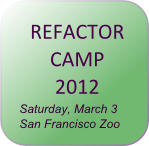On Saturday March 3rd, I am organizing a barcamp style event at the San Francisco Zoo: Refactor Camp, 2012. It is a small event, with a few scheduled speakers (including me of course) to get people thinking and talking, withe rest of the time left open, to improvise a barcamp-style agenda on the spot. Use the promotional code EARLYBIRD to register before 10 PM, Thursday Feb 16th, and get $10 off the $40 general registration.
You can find out more about the theme and inspiration behind the event in the announcement post on ribbonfarm.
If you enjoyed Tempo, the event should be of particular interest, since it is largely inspired by themes and open questions in the book. Narrative, archetypes and design thinking all feature in the developing agenda.
My own talk will build on the ideas on archetypes and cheap tricks in the book: “Motifs, Mascots and Muses.” I am developing the talk for a general audience, but those who have read the book should be able to peel back more layers in the ideas.








